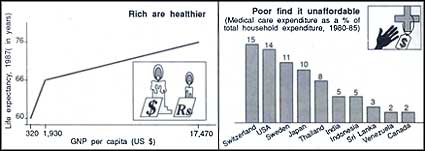Health and economy
 A COUNTRY'S economic strength influences its health level, which, in turn, is correlated with its average income level. When the economy grows, the people's health should also improve. The gross domestic product (GDP) of the industrialised West grew five-fold between 1960 and 1980. Meanwhile, male life expectancy increased by 2.7 years and by 4.4 years for females.
A COUNTRY'S economic strength influences its health level, which, in turn, is correlated with its average income level. When the economy grows, the people's health should also improve. The gross domestic product (GDP) of the industrialised West grew five-fold between 1960 and 1980. Meanwhile, male life expectancy increased by 2.7 years and by 4.4 years for females.
People's health is influenced both by the quantum of funding allocated and the way the money is spent. For example, Sri Lanka's infant mortality rate is less than half of Mexico's, though its per capita income is just about one-quarter of Mexico's.
The gap between developed and developing countries relating to per capita public expenditure on health is widening. Government funding on health is decreasing steadily in many countries because of tight budgets resulting from structural adjustment programmes. Upto 90 per cent of spending on health in sub-Saharan Africa is provided by foreign aid.
(Source: 1991 World Health Statistics Annual, WHO)
Related Content
- Tanzania economic update: overcoming demographic challenges while embracing opportunities
- Djibouti country economic memorandum: Djibouti beyond the ports and bases- a path to prosperity for all
- India's journey towards sustainable cooling
- International debt report 2023
- Benin country climate and development report
- Sewage sludge: a review of business models for resource recovery and reuse
